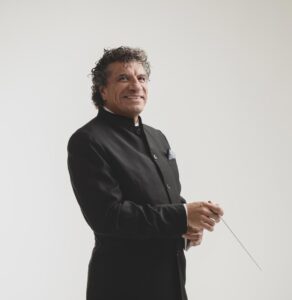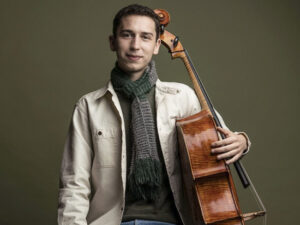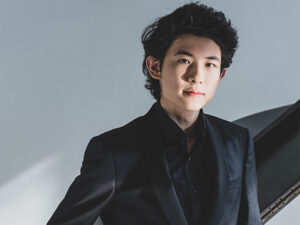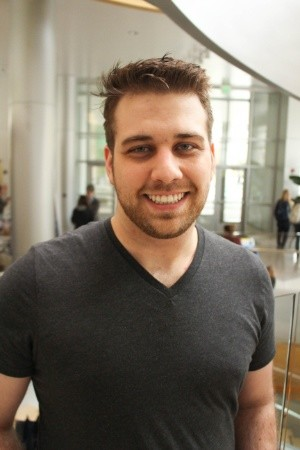Guerrero's Last Season Continues:
A Celebration to Remember: Nashville Symphony Captures Tchaikovsky’s Magic
I was lucky enough to attend the Nashville Symphony’s performance entitled “Tchaikovsky’s Celebration” at the Schermerhorn Symphony Center on Thursday, April 24th. The show was conducted by resident music director, Giancarlo Guerrero and featured guest soloists Oliver Herbert on cello and Tony Siqi Yun on the piano. The program featured a selection of some of Pyotr Ilyich Tchaikovsky’s most memorable compositions, highlighting his unique style that mixed Western European fundamentals with Russian musical traditions.

While most people may think of the Nutcracker or Swan Lake when asked to name Tchaikovsky’s most iconic work, Romeo and Juliet Overture-Fantasy may just be his most ubiquitous composition. It’s been featured in Wayne’s World, Sesame Street, The Fresh Prince of Bel-Air, South Park, The Simpsons, The Sims, and the list goes on and on. So how did Nashville’s performance stack up against the many examples from contemporary pop culture? They blew them out of the water. Guerrero’s interpretation really highlighted the juxtaposition of the piece’s beautiful, swelling melodies with its grandiose, crashing themes. The overture opens with a delicate theme in the woodwinds before transitioning to a more tumultuous section that crashes back and forth between different sections of the orchestra. Powerful brass and dynamic strings eventually break, and the famous love theme emerges in their place. I cannot emphasize enough how compelling the Nashville Symphony’s performance of this piece was. It’s truly been one of my favorite renditions from this season.

Next the spotlight fell to Oliver Herbert for Variations on a Rococo Theme for Cello and Orchestra, Opus 33. This piece was written to commemorate the centennial of Mozart’s opera Don Giovanni, and its classical inspirations have no trouble shining through. The composition features a reduced orchestra, which gives it a unique focused sound when compared to the other pieces in the program. Herbert’s whimsical performance was a joy to observe. He seemed to dance back and forth as he got caught up in the music. As for the piece itself, listeners can expect a vibrant dialogue between the cello and the rest of the orchestra as the light elegant theme is passed back and forth among its numerous iterations.

After the intermission, the night picked back up with “Concerto No. 1 in B-flat Minor for Piano and Orchestra, Opus 23. This time it was Tony Siqi Yun’s turn to give a solo performance. It was easy to see how Yun has managed to secure so many prizes and awards throughout his career. I would describe his performance as nothing less that prodigious. His interpretation of the concerto’s sweeping melodies and intricate passages was both deeply emotional and technically flawless. The orchestra provided a compelling counterpart to Yun’s masterful piano playing. The back and forth between pianist and orchestra was truly mesmerizing. The concerto begins with a bold, sweeping chords in the piano that unfold over a stately orchestral introduction. The first movement (Allegro non troppo e molto maestoso) then goes on to alternate between virtuosic piano passages and emotional, dynamic melodies. The Andantino semplice is the second movement of the concerto, which begins in the flutes before being echoed by the piano. This movement was particularly memorable, as Yun’s delicate touch and lyrical sensibility brought out the movement’s tender beauty. The final movement (Allegro con fuoco) is an energetic combination of themes from traditional Russian folk dance and virtuosic piano. There is a steady build shared among the orchestra and piano to a thrilling climax. After the concerto’s conclusion Yun also provided a short encore.
Finally, the program concluded with Capriccio Italien, Opus 45. This is a vibrant and colorful piece inspired by Tchaikovsky’s travels to Rome and his experiences during the Carnival season. The Nashville Symphony embraced the work’s festive spirit, delivering a performance full of energy and character. The opening brass fanfare was a nice change of pace, offering something a little different as it set the stage for the orchestra to come back in with the lively Italian folk melodies featured throughout the remainder of the piece. The loud and exuberant ending of the composition was a perfect way to conclude the program. It kept the audience excited and energized all the way to the very end of the show.
“Tchaikovsky’s Celebration” was a powerful evening that reaffirmed the enduring appeal of Tchaikovsky’s music. Through passionate interpretations and exquisite performances, the Nashville Symphony, along with Oliver Herbert and Tony Siqi Yun, created an experience that was both moving and memorable, earning its place as one of the highlights of this season.



